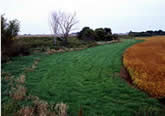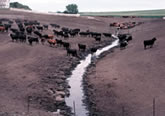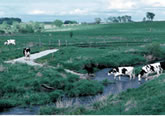
Online
Licensing
|
TENNESSEE LANDOWNER
INCENTIVE PROGRAM
This new program is designed to protect, enhance, or restore rare species habitats
on Tennessee’s private lands. TNLIP will provide 75% cost-share assistance and some cash
incentives for landowners to implement best management practices on their property. The program
focus is rare species but the final product will benefit the landowners by reducing erosion or other
negative impacts that may occur on their lands. The enhanced habitats will also serve to improve
game species by providing upland habitats for deer, turkey, quail, and other species but also
improve water quality for trout, bass, and even human uses.
| TNLIP projects will go from this:
|
To this:
|
 |

|
Photos courtesy of the USDA NRCS
Many of Tennessee’s rare species occur in the streams and rivers across the state and occur on or near many properties without ever being noticed. The TNLIP will be helping these species by improving water quality through property improvements adjacent to the streams and rivers. In a majority of the projects implemented, landowners will never see the species they are helping. In all cases, cooperating landowners should not worry about liabilities or loss of property rights with rare species on their land because TWRA will provide safeguards to ensure no change in land use rights or practices will result if endangered or threatened species are located on or near your property.
WHO CAN APPLY?
The TNLIP is a statewide program and can provide technical and financial assistance to landowners in all of Tennessee’s counties. Currently, the Duck River and Hatchie River watersheds are designated as priority areas for TNLIP and landowners on these rivers or their tributaries are highly recommended to apply for assistance. The only requirements for program eligibility are: 1) the property is privately owned and 2) the project will benefit rare species habitat.
WHAT TYPES OF PROJECTS ARE AVAILABLE?
The TNLIP is a very flexible program designed to benefit all of Tennessee’s rare species. As a result, almost any practice that will benefit a rare species could be considered under this program. A majority of the effort will be dedicated to improving aquatic habitats by reducing erosion on properties near streams. Some example projects would include:
- Channel Bank Vegetation
- Exclusion fencing
- Alternative water sources
- Field Border
- Riparian Buffer
- Filter Strip
- Stream Habitat Improvement and Management
- Grade Stabilization Structure
- Heavy Use Area Protection
- Stream Crossing
- Channel Stabilization
Conservation practices will make dramatic improvements to your land.
| TNLIP projects will go from this:
|
To this: |

|

|
Photos courtesy of the USDA NRCS
HOW DO I APPLY?
- Contact TNLIP Coordinator (615-837-6008) or submit a completed Phase 1 Application – Information.

- TNLIP personnel will recommend further program guidance and schedule a site
visit to your property.
- TNLIP personnel will visit your property, assess habitats, and discuss
potential management techniques.
- Phase 2 Application – Management Plan
 is completed and is completed and
submitted to the TNLIP Coordinator. TWRA strongly suggests landowners use free services provided
by TNLIP personnel or cooperators to provide free technical assistance and write your plan to
ensure management best addresses program criteria.
- The TNLIP review committee will rank projects based on program
criteria
 and
select the most environmentally beneficial projects for funding. Unfunded projects can be resubmitted in future grant cycles. and
select the most environmentally beneficial projects for funding. Unfunded projects can be resubmitted in future grant cycles.
- Approved projects will have final management plans, budgets, and timelines
determined and projects implemented.
HOW CAN I LEARN MORE?
Program information, descriptions, and applications can be located by following these links:
General Information 
Phase 1 Application 
Phase 2 Application 
Ranking Criteria (provided for information purposes only) 
or by contacting Gray Anderson, TNLIP Coordinator, at:
Tennessee Wildlife Resource Agency
Wildlife Division, TNLIP
P.O. Box 40747
Nashville, TN 37204
615-837-6008 Direct
615-781-6610 Wildlife Division
[email protected]
|

|

